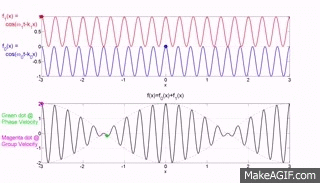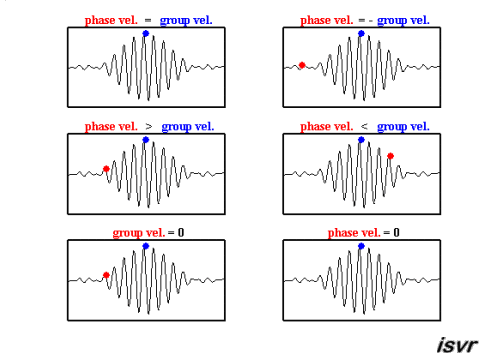This is the generic form of a dispersion relation with a low frequency cutoff. It is a good model for the dispersion relation of electromagnetic waves in a plasma, i.e. the ionosphere, where:
$$ \omega^2 = \omega_0^2 + c^2 k^2 $$
Which is the same as your form, though I've put back in $c$ for the nondispersive phase velocity and changed $k_0 \to \omega_0$ to make it a little clearer. For frequencies below the cutoff $\omega_0$ the wave number is imaginary, that is, the waves don't propagate, they are evanescent decaying exponentials. As you point out, the phase velocity
$$ v_\phi^2 = \frac{\omega^2}{k^2} = c^2 + \frac{\omega_0^2}{k^2} $$
can get arbitrarily large in the large wavelength limit. The group velocity
$$ v_g^2 = \left( \frac{\partial \omega}{\partial k} \right)^2 = \frac{ c^2 }{ 1 + \frac{\omega_0^2}{c^2 k^2} } $$
which vanishes in the long wavelength limit and approaches the nondispersive phase velocity in the short wavelength limit.
Notice that, for the case of plasmas, you might be even more concerned about the diverging phase velocity, since in that case it is quickly exceeding the speed of light. But, it is no bother. The phase velocity is a fairly artificial thing, it just relates the relative phase of different parts of our system after they have reached their steady state.
To get a good physical analogy to reason with, consider a line of pendula of mass $m$ hanging from the wall of length $l$, connected with springs with spring constant $K$ separated by a distance $a$, we get a dispersion relation of the form
$$ \omega^2 = \frac{g}{l} + \frac{4K}{m} \sin^2 \frac{ka}{2} $$
which if we take long wavelength limit (i.e. make $ka \ll 1$, so put our pendula close together or consider wavelengths small compared to their separation, we get
$$ \omega^2 = \frac{g}{l} + \frac{Ka}{M} k^2 $$
which is the same form as the one under consideration. But now we know how to reason about the situation. First, the presence of a low frequency cutoff makes sense. The pendula want to oscillate at their natural frequency of $\omega = \sqrt{g/l}$ and there is nothing we can do to compel them to oscillate any slower. This will be generic in any system that has some kind of "internal oscillation" aside from the coupling.
This is the large wavelength limit, in which the frequency of our wave is just the frequency of our pendula by themselves. Imagine the whole row of pendula all moving back and forth in perfect synchronization. Equivalently, you can imagine making the coupling between the pendula tend towards zero, which will put us in the same regime. Now all of the pendula move back and forth in perfect synchronization, so if you try to follow the motion of a "wave crest", it will appear to move at an arbitrarily fast speed, approaching infinity in the limit that our wavelength goes to infinity and all of the pendula are truly synchronized (they all have the same phase). Additionally, if we consider this as the limit of vanishing coupling, it makes sense that the group velocity should vanish, as the group velocity gives us the velocity at which a disturbance moves through our system. If the pendula's coupling is arbitrarily small, and you jostled one of them, that disturbance would move arbitrarily slowly to the other pendula.
The other end makes intuitive sense as well. As we increase the frequency of the wave, or lower is wavelength, more and more we are probing the physics of an infinite line of coupled masses with springs, the pendula bit doesn't enter into it, so we recover the physics of a nondispersive medium with constant phase and group velocities, which are equal. (As long as we don't try it with too small of a wavelength so as to ruin our long wavelength approximation in the first place).
The top two graphs from the MakeaGIF.com website are for waves of one frequency/wavelength travelling at different phase speed as shown by the motion of the red and blue dot sitting on top of a crest.
The term phase is used because you are observing the particle which make up the medium at their maximum upward excursion from the equilibrium position and the speed of that crest is measured as the distance moved by a crest divided by the time taken to move that distance.
You could have equally well chosen to follow a trough or when the particles had zero displacement or the phase $kx-\omega t = \text{constant}$.
Differentiating this expression gives the phase speed as $\left (\dfrac{dx}{dt}\right)_{\rm phase} = \dfrac \omega k$

The bottom graph is the addition of the top two graphs and you will note that a modulating envelope the peak of which as shown by the red dot travels at the group velocity where group refers to the motion of a number (group) of waves added together and $\left (\dfrac{dx}{dt}\right)_{\rm group} = \dfrac {\Delta\omega} {\Delta k}$.
This is derived from French's cosine term where you want the term in the bracket to be a maximum with $\omega = \omega_1-\omega_2$ and $\Delta k = k_1- k_2$ and follow the movement of that maximum.
Hopefully the gif animations below from the Institute of sound and Vibration Research (isvr) will help you to differentiate between group velocity and phase velocity.



Best Answer
I will try to explain the answer in a really symple way. Proabably as you know, the dispersion relation that you have written above is obtained doing some approximations (i.e. the first neighbour interaction, and the approximation that the interaction between atoms of the chain is harmonic). At this point you can imagine your 1-D mono-atomic crystal as a set of harmonic oscillators, so, if you perturbe your system, you will get an "harmonic response". The reason why in this case you can talk about speed of sound, is that you can map the nuclear part of the Born-Oppeneimer equation into a 1-D D'Almbert equation in which this speed of sound $v_{s}$ appears (i will not demonstrate it, but trust me on the fact that you can do this). As you know this equation reads $$ (\frac{1}{v_{s}^{2}} \frac{\partial^{2}}{\partial t^{2}}- \frac{\partial^{2}}{\partial x^{2}}) f(x,t) = 0 $$ Now, let's consider the classical elastic theory for continuos medium, in which the atomic nature is negligible and let's construct a parallelism with the atomic chain theory. If you perturbe a continuos medium you will obtain a wave travelling into the medium with a dispersion relation: $$\omega= v_{s} k$$ where the speed of sound (i.e. the speed of propagation of the wave due to the perturbation induced) is classicaly defined as: $$v_{s} = \sqrt{\frac{C}{\rho}}$$ where $C$ is the Young-modulus of the medium and $\rho$ is the density of the medium. At this point, let's link this classical elastic theory with the one associated to the mono-atomic chain. In other words, let's consider that your medium is made by mono-atomic chains in such a way that you have a set of atomic layers of mass $M$, section $S$ and each layer is distant $a$ from another one ($a$ is the reticular constant). For the sake of simplicity imagine that in every layers there are $N$ atoms and, finally, imagine that this medium has got a total lenght at rest $l= Na$, where N is the number of atoms that compose the linear chain. If you ideally compress it by a quantity $dl$ the response of the system is harmonic (it is, beacuase of the approximation that you have done in your linear-chain theory) and so, you will have that the response-force can be written as: $$dF = (C S)\frac{dl}{l} $$ Now setting $dl \approx a$ and remembering that the force is harmonic $dF = k(dl) \approx k a$, one has: $$ka = (C S)\frac{a}{N a}$$ notice that $S a$ is clearly the volume $V$ occupied by a layer of atoms, then multiply both members of the equation by $a$. In this way: $$k a^2 = \frac{CV}{N}$$ and using $\rho =\frac{M}{V} \rightarrow V= \frac{M}{\rho}$ one gets: $$\frac{k a^2}{M} = \frac{C}{\rho N}$$ Let's identify $m= \frac{M}{N}$ as the mass of a single atom, and so, in conclusion we get to: $$\boxed{ \frac{K a^2}{m} = \frac{C}{\rho} = v_{s}^{2} } (1)$$ In this way you have identified the speed of sound by the parameters of your mono-atomic chain theory. Now, if you see at the dispersion relation obtained in the thoery of the linear chain, you can simple derive the same exact expression that is at the left side of the equation (1) for the group velocity $\frac{d \omega(k)}{d k}$ computed for small $k$, exactly as you did in your question (apart from a dimensional factor that is in front of the dispersion relation that you have omitted). This means that you can identify the oscillation modes of the linear chain at big wave-lenght ( or $k \approx 0$) like a sound wave that is propagating into a continuos medium!